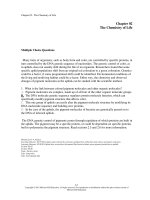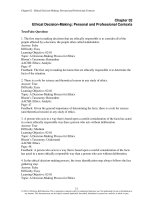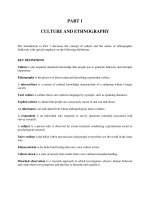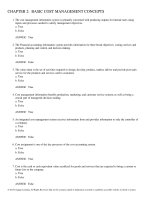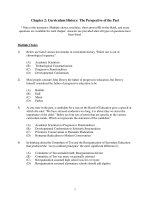Organizational behavior and management in law enforcement 3rd edition more test bank
Bạn đang xem bản rút gọn của tài liệu. Xem và tải ngay bản đầy đủ của tài liệu tại đây (376.4 KB, 16 trang )
Instructor’s Manual and Test Bank
for
Organizational Behavior and
Management in Law Enforcement
Third Edition
Harry W. More
San Jose State University, Professor Emeritus
Gennaro F. Vito
Southern Police Institute, University of Louisville
William F. Walsh
University of Louisville, Professor Emeritus
Prentice Hall
Boston Columbus Indianapolis New York San Francisco Upper Saddle River
Amsterdam Cape Town Dubai London Madrid Milan Munich Paris Montreal Toronto
Delhi Mexico City Sao Paulo Sydney Hong Kong Seoul Singapore Taipei Tokyo
i
______________________________________________________________________________________
Copyright © 2012, 2006, 1992 Pearson Education, Inc., publishing as Prentice Hall, Upper Saddle River,
New Jersey and Columbus, Ohio. All rights reserved. Manufactured in the United States of America. This
publication is protected by Copyright, and permission should be obtained from the publisher prior to any
prohibited reproduction, storage in a retrieval system, or transmission in any form or by any means,
electronic, mechanical, photocopying, recording, or likewise. To obtain permission(s) to use material from
this work, please submit a written request to Pearson Education, Inc., Permissions Department, One Lake
Street, Upper Saddle River, New Jersey.
Many of the designations by manufacturers and seller to distinguish their products are claimed as
trademarks. Where those designations appear in this book, and the publisher was aware of a trademark
claim, the designations have been printed in initial caps or all caps.
10 9 8 7 6 5 4 3 2 1
Prentice Hall
is an imprint of
www.pearsonhighered.com
ISBN-13: 978-0-13-507186-1
ISBN-10:
0-13-507186-0
ii
Table of Contents
Chapter 1
Police Organization: Evolving Strategies
Chapter 2
Dynamics of Management: Managers and Organizational
1
Behavior
14
Chapter 3
Leadership: The Integrative Variable
27
Chapter 4
Personality: Understanding the Complexity of Human
Behavior in the Organization
Chapter 5
45
Beliefs, Values, and Attitudes: Determinants of Human
Behavior
58
Chapter 6
Motivation: The Forces Behind Behavior
72
Chapter 7
Stress in Organizational Life: Its Nature, Causes,
and Control
90
Chapter 8
Conflict: Natures, Causes, and Management
108
Chapter 9
Decision-Making: The Essential Element in Applied
Management
123
Chapter 10
Power: Its Nature and Use
138
Chapter 11
Communication: The Vital Process
154
Chapter 12
Groups and Team Work: Human Dynamics at Work
166
Chapter 13
Change: Coping with Organizational Life
184
Chapter 14
Performance-Based Management: Guiding Principles
200
Chapter 15
Developing Effective Organizations: Improving
Organizational Performance
220
Answer Key
232
iii
CHAPTER 1
POLICE ORGANIZATIONS: EVOLVING STRATEGIES
TRUE/FALSE QUESTIONS
1.
Managerial and organizational effectiveness depends on willingness of employees to
support and follow direction.
Answer: True
Objective: Define the term organization and its basic elements.
Page Number: 2
Level: Easy
2.
The focus of the classical school is human resource development.
Answer: False
Objective: Identify the focus of the classical school and its organizational model.
Page Number: 3
Level: Easy
3.
In a bureaucratic organization authority is vested in the position and not the individual.
Answer: True
Objective: Identify the focus of the classical school and its organizational model.
Page Number: 3
Level: Easy
4.
During the years 1930 to 1970 individuals from within the police profession led a
nationwide movement to transform politically dominated police-departments into
rational-legal professional organizations.
Answer: True
Objective: Identify the focus of the classical school and its organizational model.
Page Number: 4
Level: Easy
5.
Frederick W. Taylor’s managerial philosophy focused on human resource development
4
and work discretion.
Answer: False
Objective: Define scientific management.
Page Number: 5
Level: Easy
6.
Henry Fayol principles of management were designed to improve organizational
performance.
Answer: True
Objective: Define scientific management.
Page Number: 6
Level: Easy
7.
Intelligence-Led Policing is a managerial philosophy based upon the concepts of
community policing.
Answer: False
Objective: Identify the characteristics of systems theory.
Page Number: 14
Level: Easy
8.
Problem-oriented policing emphasis on the use of data analysis to influence decisions and
develop crime control strategy helped in the creation of Strategic Policing.
Answer: True
Objective: Compare and contrast the organizational strategies of the four eras of policing.
Page Number: 24
Level: Easy
9.
Systems theory evolved as a way of analyzing the various environmental factors that
influence organizations.
Answer: True
Objective: Identify the characteristics of systems theory.
5
Page Number: 11
Level: Easy
10.
Compstat was developed by the Los Angeles Police Department.
Answer: False
Objective: Identify and compare the elements of Compstat and Intelligence-led policing.
Page Number: 27
Level: Easy
MULTIPLE CHOICE QUESTIONS
1.
Which of the following describes a characteristic of a bureaucratic organization?
a.
management is a part time job
b.
authority is vested in the individual
c.
management is reduced to a set of rules
d.
all of the above
Answer: C
Objective: Identify the focus of the classical school and its organizational model.
Page Number: 3
Level: Easy
2.
A limitation of bureaucracies is that they
a.
dehumanize employees
b.
loosely structured
c.
promoters of innovation
d.
limiters of make work
Answer: A
Objective: Identify the focus of the classical school and its organizational model.
Page Number: 4
Level: Easy
3.
Scientific management provides for
a.
an emphasis on individual discretion
6
b.
"Rule of thumb" job design
c.
using scientific methods work efficiency
d.
limited training of employees
Answer: C
Objective: Define scientific management.
Page Number: 5
Level: Easy
4.
Henri Fayol identified all of the following functions of each manager except
a.
planning
b.
controlling
c.
commanding
d.
supporting
Answer: D
Objective: Define scientific management.
Page Number: 6
Level: Easy
5.
Henry Fayol's principles of management were
a.
rigid
b.
dogmatic
c.
functional
d.
loose
Answer: C
Objective: Define scientific management.
Page Number: 7
Level: Easy
6.
Problems of police management identified by Leonhard F. Fuld included
a.
separation line and staff
b.
non-professional heads of police department
c.
excessive control of discretion
d.
rigid job descriptions
7
Answer: B
Objective: Define scientific management.
Page Number: 7
Level: Easy
7.
The Hawthorne effect involved
a.
pay and benefits
b.
length of the workday
c.
psychological and social conditions in the workplace
d.
none of the above
Answer: C
Objective: Identify the components of the acronym POSDCORB.
Page Number: 10
Level: Easy
8.
In the Hawthorne plant the workers code included
a.
controlling the amount of work accomplished
b.
taking as many breaks as possible
c.
assuming leadership positions
d.
leaving work as early as possible
Answer: A
Objective: Identify the components of the acronym POSDCORB.
Page Number: 10
Level: Easy
9.
The first comprehensive study of policing in the United States was conducted by
a.
August Vollmer
b.
O.W. Wilson
c.
Robert Peel
d.
Raymond Fosdick
Answer: D
8
Objective: Define scientific management.
Page Number: 8
Level: Easy
10.
Raymond Fosdick suggested that for a sound police administrative organization to
develop all of the following must be met except
a.
the relationship between supervision and work must be well
balanced
b.
the different parts of the mechanism must be adjusted to each other
c.
the leadership should be close to the community
d.
the whole machine must be adapted to its task
Answer: C
Objective: Define scientific management.
Page Number: 8
Level: Easy
11.
The elements of the term POSDCORB mean all of the following except
a.
Planning
b.
Ordering
c.
Staffing
d.
Directing
Answer: B
Objective: Identify the components of the acronym POSDCORB.
Page Number: 8
Level: Easy
12.
The father of modern police administration is
a.
August Vollmer
b.
O.W. Wilson
c.
V.A. Leonard
d.
Raymond Fosdick
9
Answer: A
Objective: Identify the components of the acronym POSDCORB.
Page Number: 9
Level: Easy
13.
Human Relations Management means all of the following except
a.
personnel aspects of the manager’s job
b.
interrelationship of the employee and the organization
c.
bureaucratic structural control
d.
believing that organizational goals and human needs are
compatible
Answer: C
Objective: Identify the components of the acronym POSDCORB.
Page Number: 10
Level: Easy
14.
The systems approach emphasizes
a.
effectiveness of tasks measurements
b.
developing one model for goal achievement
c.
interdependence and interrelationships of parts to the whole
d.
minimizing feedback
Answer: C
Objective: Define scientific management.
Page Number: 11
Level: Easy
15.
Characteristics of the open system organizational model include
a.
organization exist in a stable environment
b.
influence of environment inputs
c.
hierarchical organization of authority
d.
management by rules
10
Answer: B
Objective: Define scientific management.
Page Number: 11
Level: Easy
16.
Since the 1980’s ____________ has accelerated the organizational shift in policing from
closed to an open system perspective.
a.
scientific management
b.
classical organizational theory
c.
community policing
d.
professional reform
Answer: C
Objective: Identify the characteristics of systems theory.
Page Number: 12
Level: Easy
17.
The contingency management model consists of the following element(s)
a.
environment
b.
the individual
c.
the group
d.
all of the above
Answer: D
Objective: List the key characteristics of the contingency approach to management.
Page Number: 14
Level: Easy
18.
Police departments in the political era were characterized as:
a.
highly centralized
b.
free from political influence
c.
having strong organizational control
11
d.
providers of numerous social services
Answer: D
Objective: Identify the factors that determine police organizational structure.
Page Number: 19
Level: Easy
19.
The organizational strategy of the reform era includes
a.
close ties to the community
b.
the primary function of order maintenance
c.
application of the principle of unity of command
d.
decentralization
Answer: C
Objective: Identify the factors that determine police organizational structure.
Page Number: 21
Level: Easy
20.
The organizational strategy of the community-policing era includes
a.
limited use of task forces
b.
centralization of the patrol function
c.
social service as the primary function
d.
consultative problem solving relationship with the community
Answer: D
Objective: Identify the factors that determine police organizational structure.
Page Number: 25
Level: Easy
21.
Methods of organizing police departments include all of the following except
a.
time
b.
major process
c.
clientele
d.
assessment
12
Answer: D
Objective: Identify the factors that determine police organizational structure.
Page Number: 16
Level: Easy
22.
The strategic management process (CompStat) developed by William Bratton and the
NYPD command staff included all of the following except:
a.
information technology
b.
problem solving by policy and procedure
c.
operational strategy
d.
managerial accountability
Answer: B
Objective: Identify and compare the elements of Compstat and Intelligence-led policing.
Page Number: 27
Level: Easy
23.
The underlying principle of COMPSTAT is that
a.
community service officer’s direct strategy
b.
command discretion must be controlled
c.
planning should be centralized
d.
police can have a substantial positive impact on crime
Answer: D
Objective: Identify and compare the elements of Compstat and Intelligence-led policing.
Page Number: 28
Level: Easy
24.
The basic tasks of strategic police management include all of the
following except
a.
creation of a strategic vision
b.
translating the vision into specific performance outcomes
13
c.
emphasis on polices, rules and procedures
d.
crafting a strategy
Answer: C
Objective: Identify and compare the elements of Compstat and Intelligence-led policing.
Page Number: 30
Level: Easy
25.
Intelligence-led policing involves all of the following elements except:
a.
employs crime analysis and criminal intelligence to focus police strategy
b.
targets serious offenders and offenses
c.
uses a Compstat management and accountability process
d.
employs a community oriented neighborhood based strategy.
Answer: D
Objective: Identify and compare the elements of Compstat and Intelligence-led policing.
Page Number: 29-30
Level: Easy
DISCUSSION QUESTIONS
1. What were the classical school theorists trying to accomplish?
Answer: Answers will vary
Objective: Identify the focus of the classical school and its organizational model.
Page Number: 3
Level: Easy
2. What are the characteristics of a bureaucracy?
Answer: Answers will vary
Objective: Identify the focus of the classical school and its organizational model.
Page Number: 3
Level: Easy
3. What are the limitations of a bureaucracy?
14
Answer: Answers will vary
Objective: Identify the focus of the classical school and its organizational model.
Page Number: 4-5
Level: Easy
4. List Henri Fayol’s elements of management.
Answer: Answers will vary
Objective: Define scientific management.
Page Number: 6
Level: Easy
5. Describe the findings of the Hawthorne studies.
Answer: Answers will vary
Objective: Identify the components of the acronym POSDCORB.
Page Number: 10
Level: Easy
6.
How would you apply the open organization model to a typical medium police
department?
Answer: Answers will vary
Objective: Identify the characteristics of systems theory.
Page Number: 13
Level: Easy
7.
What are the O. W. Wilson’s nine principles of management?
Answer: Answers will vary
Objective: Identify the factors that determine police organizational structure.
Page Number: 20-21
Level: Easy
8.
What are the distinguishing features of Strategic Policing?
15
Answer: Answers will vary
Objective: Identify the factors that determine police organizational structure.
Page Number: 27
Level: Easy
9.
What are the basic elements of Intelligence-Led policing?
Answer: Answers will vary
Objective: Identify and compare the elements of Compstat and Intelligence-led policing.
Page Number: 29-30
Level: Easy
16




